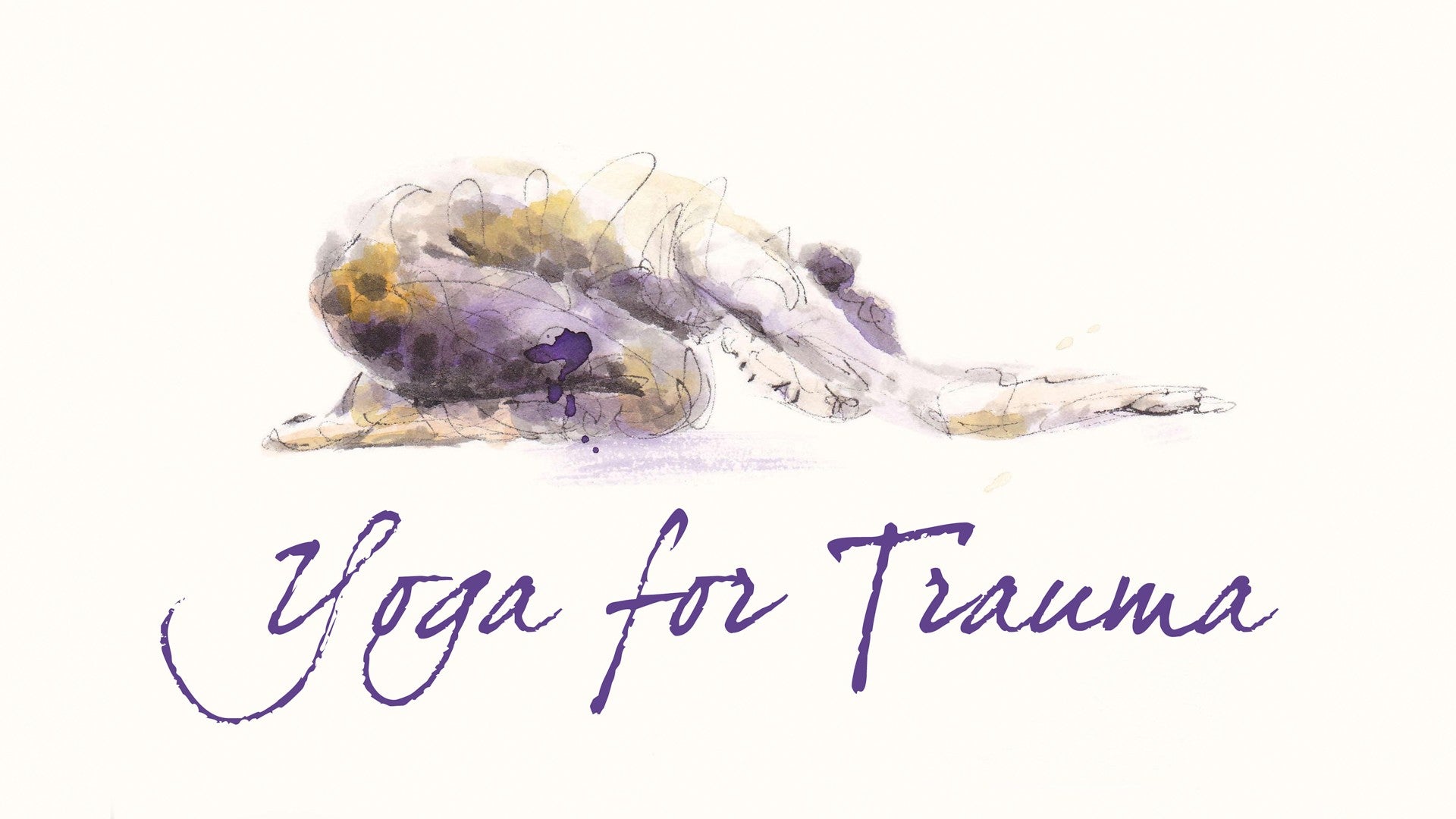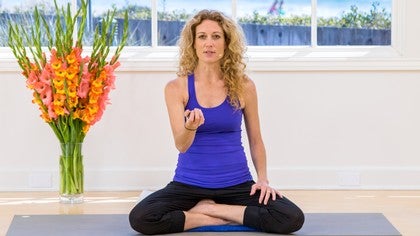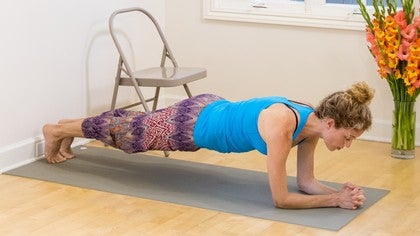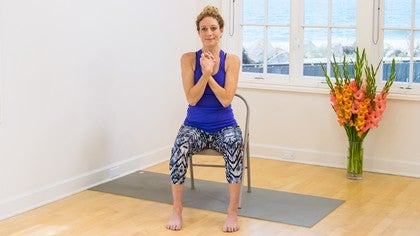Description
About This Video
Transcript
Read Full Transcript
(ocean waves) Welcome to the Resource and Tracking practice. Resources are essential to help healing a nervous system. They help us remember what is actually safe in order to touch into the inner experiences that sometimes feel like too much to go into. They're really essential to not only working with the body and movement like yoga, but also just in your daily life. A resource is anything that can help you feel grounded, centered, oriented to present time, and/or safe.
So anything that's encompassed within that calm, pleasant, easy, smooth, empowered, stable, those are anything that produces that sensation that makes you feel that would be more of a resource. Resources can be internal, so as you feel the body, some part of me, I'm sitting on the ground right now, and as I feel the floor underneath me, I get a sense of landing, like my back relaxes and I know that this ground and my sitting bones give me a sense of support. Resources can also be external, in the environment around you. So if nothing in my body feels particularly good or I'm not aware of it, I might just scan my environment for something that's actually just interesting or nice to look at. I'm really fortunate to be in this gorgeous environment right now, where I have a lot of resources available to me.
As I look around and I see the ocean out of the window, I see the ocean and my stomach gets a little softer and more open. The heart rate goes down and I realize there's more calm and space. So that could be an example of how your external environment can impact you. It doesn't have to be the ocean, though. It could be, you know, a puppy that's in the room.
It could be the way the light's just falling on the floor, a flower or a leaf. Even the small things can be resources. They can also be imagined or memories. An example of this could be your favorite place. Right now, just wherever you're sitting, bring to mind one of your favorite places: the woods, the beach, a particular room in a particular place.
Just notice how that affects you. Then if I were to say, the smell of baking cookies. See how that affects you. Your favorite piece of music. Maybe windchimes.
So as you start to think of these either remembered or imagined spaces, sounds, you'll also have a sensory experience. The other piece of this practice is more tracking. Tracking is really looking inside and just feeling what our inner sensory experience is. So many of us take for granted that we actually know the language of our inner body's experience, but when we start to give it more details and attention, it can often feel like you're a caveman in a spacesuit trying to figure out this new landscape. So feel free to be patient with yourself as you go into it.
Once you do learn this language, though, of your inner world, it can start to give you more insight as to what situations are okay to approach and what should be avoided, like which path you should go down and what really works for you and what you like and what supports your heath and well-being, and what just doesn't. So for this first resourcing exercise, it would be helpful if you had an object nearby that you actually really like, or something that makes you feel kind of supported or brings good thoughts to mind. I actually have a rock right here. For me, it brings up a good memory of where I found it, in a stream in the woods, and also the weight and the stability of this rock is nice for me. For you, it might be something different.
It might be a soft piece of cloth, it might be a picture of something. If you don't have an object nearby, that's also completely fine. Bring to mind something or even someone that gives you a good sense of comfort, safety, stability. Now, if you have it in your hand, take a moment to really feel it. If you're visually looking at it, go ahead and gaze at it, take in the colors.
If you're thinking of someone or something, feel free to close the eyes as well. You're welcome to do this with eyes open or closed at any time. But paying attention on purpose to your body's reaction as you hold this object or connect with this object. See what, if anything, allows you to get a little bit, either heavier or grounded, see if anything opens or bubbles or smooths out. We'll all have slightly different experiences with our resources.
I'll describe a little bit of my internal experience. I notice the weight in my hands, and that gives me more connection or weight into my lower belly. As that happens, it feels like there's more space around the heart, and I notice that I can breathe a little easier just by having this connection here. My awareness also goes more into me rather than into my outer environment. Take your time to feel anything you feel.
Might be temperature shift, hot, cold. You might notice that something moves from feeling wooden or hard to a little softer and smoother. But trying to locate, on purpose, anything, any place that has more ease, comfort, stability or safety. Your mind is so good at trying to find the things that don't feel good, to make sure that it's okay or safe or it's adjusting. See if you can give a little bit more attention to just your body's reaction and the sweetness to this favorite object.
Nice. Okay, so whenever you're ready, you can spend as long as you want to with that exercise, and feel free to keep coming back to just play around, maybe with different objects. But when you're ready to shift to the next one, set the object to the side or kind of give your brain a little bit of space, and we'll move to the next resourcing tool, to orienting. I use it so much. With an overwhelm of stress, trauma, anxiety, depression, we tend to go into tunnel vision, where it's like the only thing you can see or hear is this small, myopic piece of your life.
Allowing your eyes, your head, your neck to turn and take in your larger environment can actually help open up your perspective, both in the physical body and in your mind. Try it. See if you can allow your head and neck to slowly turn and notice what you notice. Check out if there's anything really sweet to look at or just interesting, or just even as you come out of your own small tunnel, what it's like to have the world or the perspective open up a little. You can do this as often as you need, especially if you catch yourself checking out or spacing out.
Try this, just coming back, looking in this space. If you need more direction, look for three things that are blue. So the next tool is just grounding. Really simple. Wherever you're sitting, bring your mind's awareness there.
For me, it helps me to actually move and wiggle into the seat to feel like, oh yeah, my hips are on the floor, my legs are on the floor. Sometimes, I'm feeling really anxious or maybe not quite in my body yet. I'll bring my hands down and just press into the earth. Having yoga mats there or something squishy there is also nice to be able to make an imprint. You might imagine that you're pressing your hands into sand or really getting into the texture of earth or dirt.
If you actually have nature around you, go ahead and put your hands in nature. And now, as you do this, I'm gonna actually ask everyone to bring your hands down onto the floor and wiggle in and check out what the body does. If being folded over works for you or creates a sense of more connection, then stay here. If it doesn't, shift out. But keep the awareness of anything that's heavy and connected.
As you feel this connection, how's your breath? Is anything shifting? So just bringing awareness to ground, you can do this not only physically, but also, like we mentioned before, resources can be imagined, so bring your awareness to a thought or an image that actually connotes groundedness. For me, I think of the earth and soil deep in the woods. It's really rich and heavy and moist.
You might think of tree roots or a huge rock, a mountain. Notice your spine and your belly when we talk about these images, an anchor. Does the spine get longer, does it get smaller, does the belly get tighter or does it start to open? Does anything feel more upright? These are all just sensations you might be looking for.
Spend a moment now to really bring to mind your images that represent roundedness, connectedness. I'd even write it down on a piece of paper. Put it in your wallet and when you start to feel like you're flying out, look at those, bring your mind's awareness. Let's shift to the next one. So the next one is gonna be helping to rumble and open up the system a little bit.
A lot of anxiety, a lot of tension. We can feel like we're closing in on ourselves. There's a main nerve that runs from the, it's the tenth cranial nerve that goes from the base of the skull all the way down into the gut and then another branch of it goes from the brain all the way down through the heart and the face and the lungs. When we make sound, particularly a lower, deeper frequency, it tends to vibrate that nerve that goes deep into the guts. It's a little bit like a pacemaker for this nerve that actually enervates or goes into all of the internal organs in the lower belly, and remember with stress?
Stress just shuts down the gut. What we're doing is we're gonna send a little vibration here. If you've ever been to San Francisco, you'll know that there's lots of fog. There's a lot of lighthouses around there, too. The lighthouses make this deep, low rumbling, of voooo in order to call the ships into safety, so we're gonna do that and that sound vibrating the nerve, the vagus nerve.
Whenever you're ready, and remember, if any of this feels like it's too much or the set making the sound is too triggering, press pause, back off, go back to your image or your safe object, take a break. But if you're still doing okay, we're gonna take a breath in, we'll exhale the deep, low voooo all the way to the end of our exhale. At the bottom, we'll let the breath come back in and we'll do it again. Okay? Should get comfortable, sense the ground, and take a deep inhale.
Then (lighthouse hum). (inhales) (lighthouse hum) Just paying attention on purpose to the response to that, if there was any. Some of you may have noticed a breath, or bubbling or space. There may have been a whoosh and then an opening somewhere that may have actually made you shake a little bit, in which case maybe that wasn't a resource for you. Some of you might feel a little heavier or more open.
If it gave you a sense of centering, connecting, ease, space, safety, consider using this as a resource. It actually can be really helpful to do, if this works for you, to do it a couple of times like before you sleep, especially if you're dealing with sleep issues. Now since, for some of us, that will have impacted the belly, let's bring the hands actually right onto the belly area. If this isn't a comfortable place to bring your hands, just take your hands off. That simple, it's your choice.
But we'll breathe into the hands, almost as if there's a balloon in the belly and then exhale as if you're deflating. This can be as long as is comfortable for you, but no force. We'll do that two more times, just a balloon breath in the belly. Again, giving this gut that tends to be shut down with a lot of stress some extra space. One more time, just breathing into hands.
Our voluntary or our conscious connection to our breath has a direct impact on our heart rate, which has an impact on the nervous system and vice versa, so if we can sometimes slow down our breath to slow down our heart rate, things might seem a little bit more possible and doable. Sometimes it's really just connection, because at the end of the day, connection is so vital to healing any sort of hurt. Place your hands somewhere where you feel connection and it might be hand on heart, it might be one hand in the armpit, the other hand to the outside edge, just someplace where when you look, it feels a sense of ease. Then take a moment or two to notice the pressure of your hand on the body. Then take a moment to notice how your body is actually receiving the hand.
If you could slow down and just get curious with how this support feels, you might notice that there's also a physical component, a reaction. Being able to be here and just show up for yourself and create stability and groundedness and centeredness, and compassion for yourself. In the previous practice, we worked on some exercises that can help us track positive, easy, comforting resourcing sensations. But tracking and learning that language of that interior body is also really important for managing and dealing with uncomfortable situations and creating more of a distress tolerance in a way. It would be great if everything was easy and sweet and if you just did enough yoga or meditation, you had no problems, but unfortunately, that's probably not gonna happen, so how do we manage it when negative thoughts come in or challenging experiences come in and kind of throw us for a loop?
Being able to pause when you notice your internal experience and name that experience, like, wow, that was just a really difficult thought, or ouch, my stomach just clenched up when I saw that person. It will at least help uncouple some of the fear and overwhelm that can throw us for a loop when we have those experiences. The first step is to be able to name it and then the second step is to be able to pause, get curious, and track our physical reactions to it. When we're able to track these sensations and pause the story for a moment just to be with that physical experience, it often just changes on its own. So for an example, I might see something or hear something and I go, ouch, oh my stomach hurts, and I realize that really makes me jealous or uncomfortable.
As I pause the story for a moment of what's going on in my brain, I might notice, oh, my stomach got tight, and when that gets tight, my breath gets shorter, my chest feels tighter. I'm gonna notice my chest instead of trying to avoid that uncomfortable feeling. Then I notice it, and as I notice it, I realize, my body loosens up a little bit and just takes a breath on its own. Okay, it's easing up. It's all usually a cycle.
Expansion and then contraction and expansion again. It's us being able to kind of ride that, ride that cycle. Jon Kabat-Zinn, the meditation teacher, has a really great phrase of, "You can't stop the waves, but you can learn to surf," and it's the same thing with this internal sensory experience. Now, in the event that you actually touch in and you feel something really difficult or a thought comes in or you see something that triggers you and it's a lot and it doesn't feel like it's moving, no matter how much you stay, and it's starting to make you nervous, what you get to do is just shift back to those resources you worked on in the previous practice. You can think of that object.
You can think of that place. You can take a couple of breaths. If you have the space, you can take a couple of voos. Remember, if it starts to feel like it's too much, touch back in to the places that feel safe and good and easy, even if it's just an imagined thought. Then, return back into it.
We're not trying to avoid the hard stuff forever, but we definitely want to give our systems time to, oh yeah, breathe again and then touch into the hard stuff. As you go back and forth between the easy, safer things and the more challenging experiences, your body will start to regulate that and also create more capacity to feel. We're gonna go through an exercise right now. If you do get triggered like that, go back to your resources. It's gonna possibly bring up some moderate to intense activation and instead of letting yourself loop into the story and go down and down that rabbithole, pause the story once we get into it and just track your body.
Again, get yourself comfortable. Here's a scenario. You have to make a flight, and the word flight in and of itself may have some people already kind of right there. You have to make a plane flight and so you get to the airport and you have just enough time and you realize the whole check-in line is around the block and there's a good possibility you won't make your flight. Pause the story and just notice what's happening as you think about that scenario.
Did something get tight, did something start to sweat, did something start to get shaky, did you get angry, does this have no impact on you? Notice if your mind wants to start to problem-solve. If the mind's getting involved, just pause for a moment and shift its awareness back into physical sensations. Now, if a lot of things just got tight, pick one place, so if it's the stomach and the chest, pick one of those and it doesn't matter which. Then as you pay attention on purpose to maybe the tightness in the stomach, the knot, does that have a shape?
Does that have a color? As you pay attention to it on purpose, notice if there's breath. You don't have to bring any breath in, just notice what actually is there. For some of you, that might just have started to shift and change and ease up, and for others of you, it's still a little tight. If that's the case, try to find a place in your body that feels the opposite of that initial response, or at least feels different than that tightness or that constriction.
It might be your foot. Pay attention on purpose to the opposite place. Then bring the awareness back to where it was tight. Notice if it is as tight as it was before. Consider spending some time to go back and forth between the space that feels kind of the opposite and the space that feels a little bit tight and just see if it does loosen up on its own.
Again, if it doesn't, shift back to the resources for now. You can use this for just about anything throughout the day, so feel free to start working this practice of tracking internal experience when you have the space, not while you're driving, but when you have the space, maybe in work, at home, just paying attention on purpose to see how the body moves in and out of these different experiences. I look forward to exploring and reinforcing this work, the tracking and the resources, through the rest of the practices that we have to offer during the show. Thank you.
Yoga for Trauma
Comments
 . Good to meet you. xoxox
. Good to meet you. xoxox
You need to be a subscriber to post a comment.
Please Log In or Create an Account to start your free trial.












